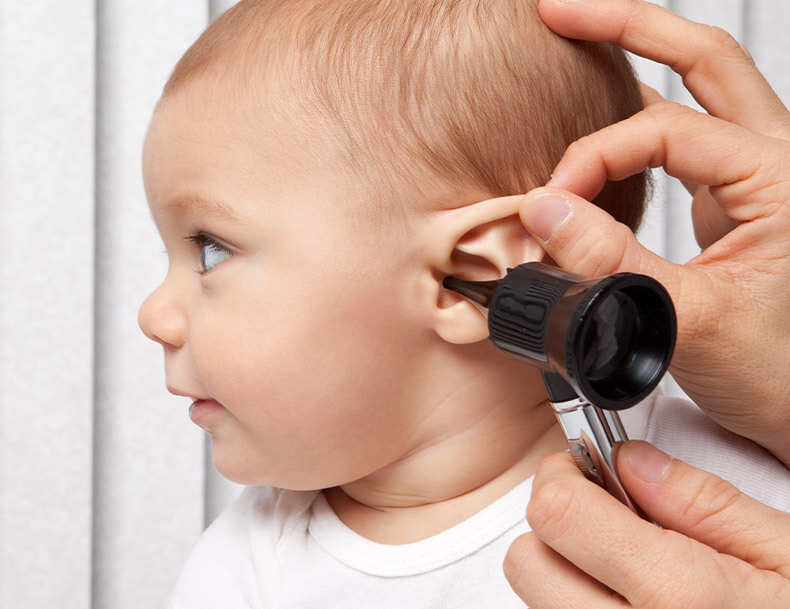> Hearing
Developmental Milestones
Home / Hearing / Developmental Milestones
It is important to know if your baby can hear. The first months and years of a baby’s life are very important for developing language. Undetected hearing loss is one of the causes of delayed language development. Delayed language development can lead to behaviour and emotional problems and later, to problems in school.
These developmental milestones show some of the skills that mark the progress of young children as they learn to communicate. There are also some tips on how you can help your child develop speech and language skills.
By 6 months
- turns to source of sounds
- startles in response to sudden, loud noises
- makes different cries for different needs – I’m hungry, I’m tired
- watches your face as you talk
- smiles and laughs in response to your smiles and laughs
- imitates coughs or other sounds – ah, eh, buh
By 9 months
- responds to his/her name
- responds to the telephone ringing or a knock at the door
- understands being told “no”
- gets what he/she wants through sounds and gestures e.g., reaching to be picked up
- plays social games with you e.g., peek-a-boo
- enjoys being around people
- babbles and repeats sounds – babababa, duhduhduh
By 12 months
- follows simple one-step directions – “sit down”
- looks across the room to something you point to
- uses three or more words
- uses gestures to communicate – waves “bye bye”, shakes head “no”
- gets your attention using sounds, gestures and pointing while looking at your eyes
- brings you toys to show you
- “performs” for attention and praise
- combines lots of sounds as though talking – abada baduh abee
- shows interest in simple picture books
By 18 months
- understands the concepts of “in and out”, “off and on”
- points to several body parts when asked
- uses at least 20 words
- responds with words or gestures to simple questions – “Where’s teddy?”, “What’s that?”
- demonstrates some pretend play with toys – gives teddy a drink, pretends a bowl is a hat
- makes at least four different consonant sounds – b, n, d, g, w, h
- enjoys being read to and looking at simple books with you
- points to pictures using one finger
By 24 months
- follows two-step directions – “Go find your teddy bear and show it to Grandma”
- uses 100 or more words
- uses at least two pronouns – “you”, “me”, “mine”
- consistently combines two or more words in short phrases – “daddy hat”, “truck go down”
- enjoys being with other children
- begins to offer toys to peers and imitates other children’s actions and words
- people can understand his/her words 50 to 60 per cent of the time
- forms words and sounds easily and effortlessly
- holds books the right way up and turns pages
- “reads” to stuffed animals or toys
- scribbles with crayons
By 30 months
- understands the concepts of size (big/little) and quantity (a little, a lot, more)
- uses some adult grammar – “two cookies”, “bird flying”, “I jumped”
- uses more than 350 words
- uses action words – run, spill, fall
- begins taking short turns with other children, using both toys and words
- shows concern when another child is hurt or sad
- combines several actions in play – feeds doll then puts her to sleep; puts blocks in train then drives train and drops blocks off
- puts sounds at the start of most words
- produces words with two or more syllables or beats – “ba-na-na”, “com-pu-ter”, “a-pple”
- recognizes familiar logos and signs – McDonalds golden arches, stop sign
- remembers and understands familiar stories
Quick Tips:
Here are some tips on how you can help your child develop hearing skills.
Babies like it when you:
- Get down to their level so they can see your face. This tells them that you’re interested in what they’re doing and saying. It makes it easier to interact with you.
- Repeat the sounds they make. Babies enjoy making noises, and like it when you imitate them over and over.
- Sing and laugh, especially when you are feeding, bathing, and changing them. Remember to talk to your baby throughout the day about things you do and see – “Mommy’s putting on her coat”, “That’s a big truck”
- Tell them the names of the objects they are looking at and playing with. Babies are interested in exploring and learning about new things, and like to hear what things are called.
Toddlers like it when you:
- Let them touch and hold books while you point to and name the pictures.
- Use real words instead of baby talk – “give me” instead of ta ta or “bottle” instead of baba.
- Take the time to listen to them – they want you to hear all of their new sounds, words and ideas.
- Give them simple directions to follow – “Go find your red boots”.
- Use lots of different words when you talk to them – opposite words like up/down, in/out; action words like “running”, “splashing”, and descriptive words like “happy”, “big”, “little”, “clean”, “dirty”.
- Encourage them to play with other children – at the library, play groups, park.
From: Ontario Ministry of Children, Community and Social Services













